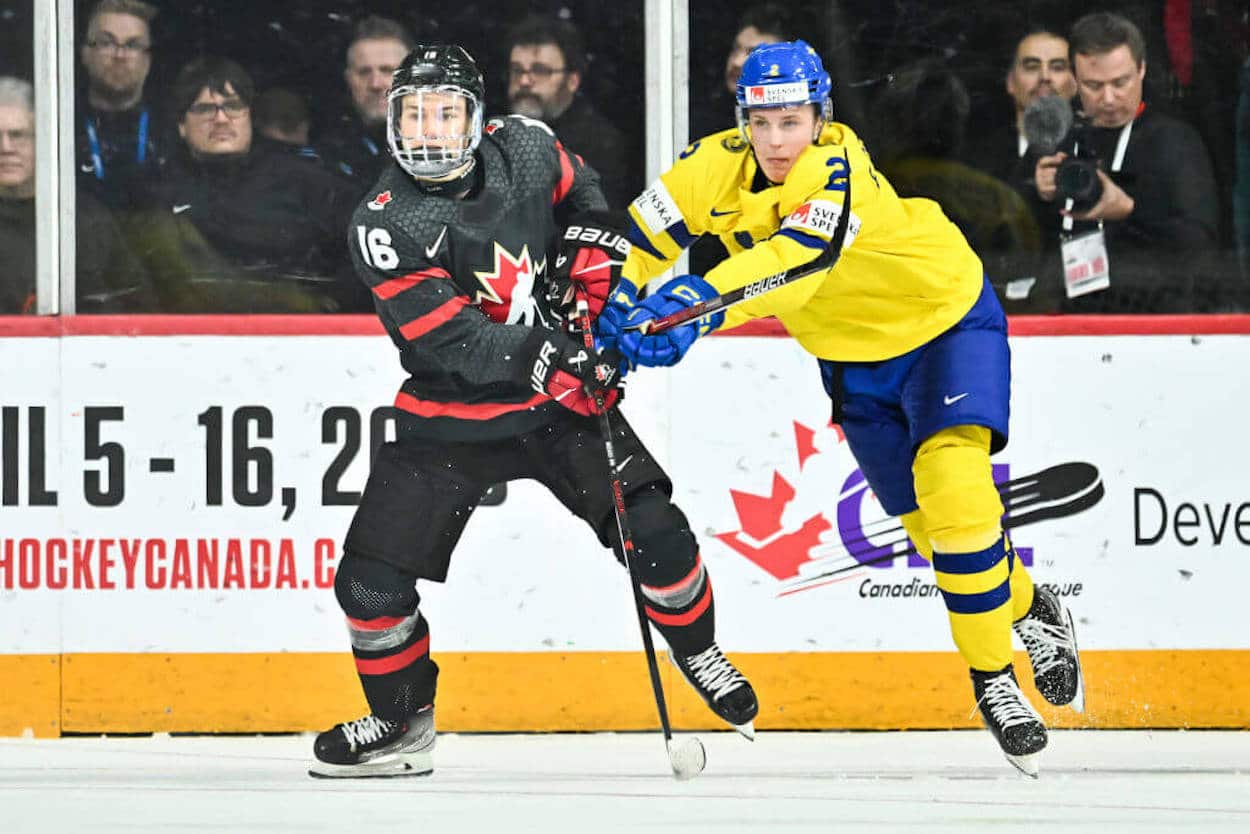NHL
Connor Bedard’s Physicality Could Help His NHL Career, but Not In the Way You’d Think

Depending on your perspective, physicality in hockey can be a divisive topic. Some argue that toughness and hitting are key parts of life on the ice; you have to earn your space, and you don’t do that by avoiding contact. On the other side of the aisle, though, others argue that the importance of hitting is overstated. NHL players today are incredibly skilled, and they’d be better served making plays rather than worrying about finishing checks and fighting. No matter your perspective, though, just about everyone can agree that Connor Bedard looks like he’s going to be a special player.
With that being said, though, the former Regina Pats star isn’t exactly known for his physical play. The young center is on the smaller side and, as he proved at World Juniors, is capable of weaving magic in the offensive zone. If you’re hoping to see him lay the body along the boards, you’re only setting yourself up for disappointment.
At the same time, though, scouts have been noting that Bedard is tougher than you think. And, no matter your perspective, that could be invaluable for his early NHL career.
Let’s break it down.
Connor Bedard impressed scouts with his physicality in addition to his scoring
During his journey to the NHL, there isn’t much left unsaid about Connor Bedard. The forward’s performance in the WHL and on the international stage made him the first pick in the 2023 NHL Draft. That presumably took some of the work off of scouts’ plates — you weren’t really trying to figure out if you want to pick him or not — but it doesn’t mean that he isn’t worth watching.
As laid out by Steven Ellis of Daily Faceoff, scouts were still learning about the teenager as the big day approached. Take, for example, his willingness to play rough.
“He looks quite comfortable throwing hits for someone that’s mainly out there to inflict pain with the puck,” an unnamed scout said. “He’s confident in himself. And that goes a long way.”
Earlier in this piece, I mentioned that the North Vancouver native isn’t the biggest player around. And while that’s certainly true — he clocks in at 5-foot-10 and 185 pounds — that doesn’t seem to be a limiting factor. If anything, it gives Bedard the element of surprise.
“Players underestimate him because of his frame,” another scout added. “Don’t judge a book by its cover, I guess.”
And while it’s cliche to say that a young player needs to grow into his body and hit the weights, that’s what another observer believes separates Bedard from the top level. Once he does that, the forward will (theoretically) be unstoppable.
“Imagine if he added a bit of extra muscle,” that scout noted. “He’d truly be a complete player.”
That toughness could help Bedard earn his coach’s trust as much as anything else
Despite the comments about Connor Bedard throwing hits and adding muscle, it’s unlikely that his physicality will make that much of a difference on the ice. While you don’t want to be seen as a soft touch, the center’s size and draft status make it unlikely that he’ll ever be expected to really lay the body. With that being said, though, that perception could still help his NHL career get off to a good start.
While Chicago bench boss Luke Richardson isn’t as old school as someone like John Tortorella, he’s not going to treat the talented rookie with kid gloves. A story in The Athletic, for example, described the coach as someone who “walks a fine line between player’s coach and hard-ass … [and is] extremely likable guy who makes sure his teams feel like a family, but he also expects an awful lot of his players in terms of work ethic and dedication.”
He’s also known for developing talent and, as a former NHLer, will want to make sure Bedard handles himself in the right way at the pro level.
It’s safe to assume that showing a bit of sandpaper will go a long way in proving that the young star is worthy of playing big-time minutes.
For an alternate riff on the same topic, consider what Scott Wheeler wrote about Bedard in The Athletic. While he noted that the teenager would probably be more of a Patrick Kane rather than a Sidney Crosby — meaning the center has elite offensive upside but won’t make a true two-way impact — the idea of earning ice time reared its head.
“I do, however, think he has point-per-game (or at not far off) potential next year in the right situation, though,” Powers explained. “He’s going to play PP1 right away and rack up points there,” Wheeler continued. “With the right linemates and deployment at five-on-five (he’ll probably need a coach who is going to play him 17 to 19 minutes per game), I don’t think 35-40 goals or 70-80 points is out of the question at all.”
With that being said, Bedard will need to strike the right balance, especially during his early days in the pros. Evolution is good, and if a bit of physicality can earn him both playing time and a bit of space on the ice, it will be well worth the effort. At the same time, though, the forward shouldn’t change what made him so special. He didn’t become the first overall pick by chance.
Will he be able to toe that line and improve without losing what made him so special? Only time will tell, but it will certainly be fun watching things unfold.











